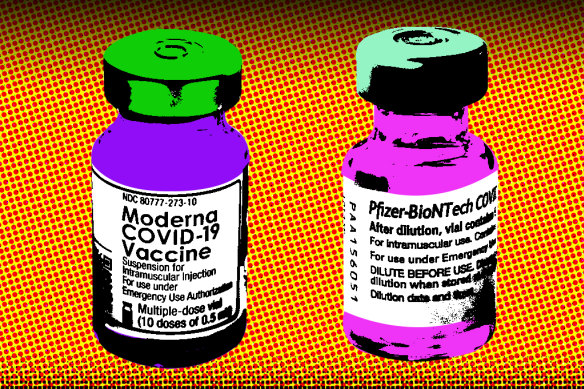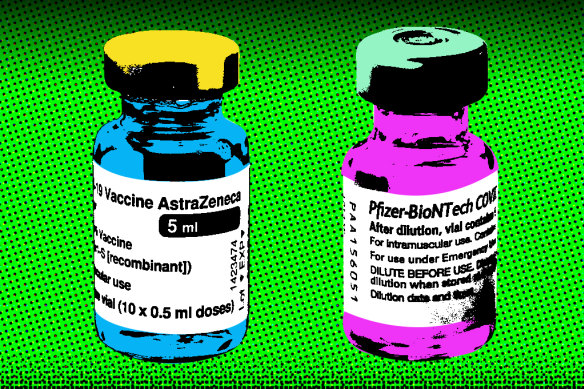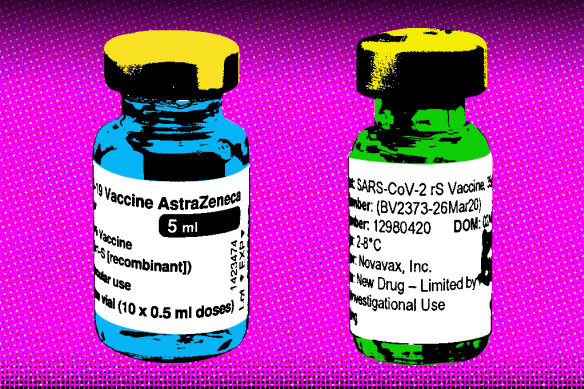- Explainer
- National
- Coronavirus pandemic
Explainer
Best of both worlds? Should we mix or match vaccines?
Can you try a Pfizer with an AstraZeneca? What about a Moderna with a Sputnik V? A quick guide to the science.
Cassandra Berry, a professor of immunology at Murdoch University, is waiting on her second dose of the AstraZeneca vaccine. But she expects an mRNA shot such as Pfizer (which requires only three weeks, not three months, between doses) would do just as well. “In fact, I think it’d be better,” she says.
Mixing vaccines is not new; scientists such as Berry have been using the tactic to try to boost immunity against influenza and Ebola for years. In June, German chancellor Angela Merkel switched shots mid-stream from AstraZeneca to the mRNA Moderna, and countries such as Canada, Sweden, Spain and France are also mixing COVID vaccines, often as preferred policy. But, while all the new vaccines approved around the world are safe and effective, how they perform together is less clear. Many experts, including in Australia, are urging people to stick with the plan and “match, not mix”. That’s what it says on the bottle after all. So is Australia likely to mix it up any time soon?
Credit: Artwork Monique Westermann
Why mix, not match?
Mixing vaccines means you get one brand for your first dose and another for your second. (It doesn’t mean two vaccines stirred together in one shot.) For COVID, trying out combinations largely started because of concerns about a rare blood-clotting reaction in a small number of people receiving the AstraZeneca shot. In March, many European countries stopped that vaccine altogether, leaving some people only partially vaccinated, unless they switched to a different brand for their second shot. Some countries have also offered combinations due to concerns about newly evolved variants of the virus evading particular vaccines (the United Arab Emirates now offers an mRNA vaccine booster after China’s Sinovac shot, for example).
So far studies in the UK, Spain and Germany suggest combining vaccines is just as effective as sticking with one brand, in terms of your body’s immune response. In fact, in some studies, mostly examining the combination of AstraZeneca and Pfizer, it seemed to make it even better, “both broadening and strengthening immunity”, says Professor Robert Booy of the University of Sydney and Australia’s Immunisation Coalition. The mixed doses have also been linked to a higher chance of common side-effects such as flu-like chills and aches, but this could be a sign of a bigger immune response (although that’s still a live question).
All the vaccines are effective when taken as intended (two doses of AstraZeneca or Pfizer work well in stopping the more contagious Delta variant, for example), so experts have cautioned against people independently seeking out combinations. The decision to mix is more for countries at a policy level. If they know combinations work, they might be able to make up for supply shortfalls of a particular vaccine – “like Pfizer in Australia”, says Booy – by doling out just one dose of that vaccine instead of two, with another brand. Or they could shorten windows between doses to build population immunity faster (say, by giving mRNA vaccines second instead of waiting the optimal 12 weeks between two AstraZeneca shots).
And, if you are one of the rare cases to have an adverse reaction to a vaccine, such as anaphylaxis or clotting, you’ll likely be offered a different vaccine for your second shot. An Australian government spokesman confirmed that, while Pfizer and AstraZeneca are “not considered interchangeable” under the current data, they can be used together in cases of adverse reactions.

Credit: Artwork Monique Westermann
OK, but how does it work?
Vaccines teach your body to mount a defence against a virus without you ever having to catch it. In the case of COVID, they do this by giving you a tiny piece of the coronavirus, the signature spike protein it uses to break into our cells – this won’t make you sick but, like a mugshot, it will help the antibodies and T cells of your immune system hunt down the viral invader fast if it arrives on the scene. “Antibodies can be made to fit the right shape of the virus and gum it up so it can’t get in,” says ANU immunological researcher Professor David Tscharke.
The difference between vaccines comes down to how they deliver this advance warning. In the case of the AstraZeneca, Russia’s Sputnik V and the one-shot Johnson & Johnson (J&J) vaccines, another harmless kind of virus (known as a vector) delivers the piece of COVID needed to build immunity. The new mRNA vaccines Pfizer and Moderna use a segment of the coronavirus’s genetic code, while China’s vaccines use dead coronavirus under older technology. Changing the method of delivery between doses, experts think, could help the immune system focus on COVID without getting distracted by the vaccine’s packaging. “Your body won’t start making antibodies for say [the vector] virus used in AstraZeneca as well as COVID,” Tscharke says.
Antibodies are the body’s first wave of defence, and where most attention is drawn in the COVID immunity fight, but they’re not the whole story. Killer T cells are also sent out once an infection takes hold to eliminate infected cells and so can be crucial in preventing more severe disease. All the approved vaccines give you high levels of antibodies, says Griffith University infectious disease professor Nigel McMillan. But mRNA vaccines Pfizer and Moderna seem to generate the most, while the vector vaccines are notable for producing many T cells primed to kill the virus. It may be that combining vaccines like AstraZeneca and Pfizer gives you the best of both worlds, or as Booy says, “the antibodies neutralise the virus and the T cells gobble up whatever gets through that”.
Tscharke, whose own treatment for multiple sclerosis means his body can’t produce antibodies properly, says work is underway to determine how many antibodies could be expected to confer immunity to COVID, and how important T cells are to the picture. “Antibodies are probably still the key, your body will build a T cell attack itself if the virus gets through,” he says. “But we do know that a poor T cell response early on means you tend to get quite sick so if you have a vaccine that [primes your] T cells that’ll still give you a jump on the virus.”

Credit: Artwork Monique Westermann
Does the order or combination matter?
Scientists think so. They are testing just about every combination, including using China’s Sinovac and Sinopharm vaccines, Russia’s Sputnik, and the US vaccine still to be approved, Novavax (which Australia has ordered 51 million doses of). Even the one-dose J&J is being trialled with an additional booster shot from another brand to see if that improves its performance against variants. “Novavax may prove to be a really beneficial booster for us here in Australia, to broaden our immunity,” Berry says.
McMillan says trials so far suggest the order matters, too. In terms of antibodies, he says using AstraZeneca before Pfizer seems to work better than the reverse order, although more study is underway. Both combinations still produce more antibodies than two AstraZeneca doses – up to nine times as many – but Pfizer alone still gives the most.
Of course, studies comparing antibody levels are not the same as real-world case numbers and hospitalisation rates, he says, which tell you how a vaccine is working on the ground. We don’t have that data for mixed vaccines yet.

Credit: Artwork Monique Westermann
So should we all use two different vaccines?
Australia’s health authorities review the evidence on vaccines all the time. But, so far, Chief Medical Officer Paul Kelly has urged people spooked by rare clotting cases linked to AstraZeneca not to cancel their second dose of the shot in order to wait for Pfizer. “Please, we are not mixing and matching at this point,” he said in late June. “You need to match, don’t mix.”
No safety concerns have emerged so far with mixing and if that holds true Berry says a combined vaccine schedule would get Australia to full immunity faster, including young people still waiting for their shots. “And the protection would [likely] last longer too, you’d get more cross-protection [to variants] and a deeper immune memory.”
Still, McMillan says, “health authorities tend to be very reluctant to mix and match doses at the moment, and I don’t know if Australia would want to go down that route just yet, quite frankly.”
Booy agrees that waiting to see how mixing vaccines plays out in other countries at scale is wise at this stage. “More and more places are [mixing] so we will see more of the real-world data we need, like when the vaccines first arrived,” he says. As the lead scientist of Oxford’s big mix-and-match trial, Matthew Snape, told reporters in June, in small studies “you do not pick up [your rarer] one-in-1000 side-effect, let alone your one-in-50,000 side-effect”. So, right now “you are better defaulting to the ones where we know that they work”. But if shortfalls mean it’s a question of taking mixed doses or no second dose at all, then he says mixing vaccines would be the better option.
And, as the virus continues to mutate, experts expect we will be getting different booster shots anyway, likely using mRNA technology that makes it fairly fast and cheap to tweak for variants.
”In the same way that the influenza vaccines are modified to protect against newly circulating strains each season, COVID-19 vaccines may in future be adapted to protect against SARS-CoV-2 variant strains,” an Australian health department spokesman said. Those will be considered, as more data comes to light on the duration and real-world effectiveness of the vaccines already being used in Australia, Pfizer and AstraZeneca, he said. In late 2021 and into 2022, 25 million doses of the mRNA Moderna will be added to Australia’s vaccine roll-out, 15 million of which are an updated variant booster – though Moderna, approved in the US, still has to be greenlit by our own regulator.
”You hear already [around the world] of families where everyone in the househas had a different combination of vaccines,” says chair of epidemiology at Deakin University Professor Catherine Bennett. “And we’re moving into an era where a lot more serology [blood tests] will be done to understand how long immunity lasts, too. These vaccines will probably cover us for more than a year, but we’re still learning what works best.”
With additional reporting by Stuart Layt
Let us explain
If you'd like some expert background on an issue or a news event, drop us a line at explainers@smh.com.au or explainers@theage.com.au. Read more explainers here.